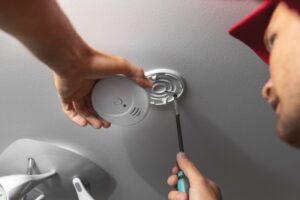We’re accustomed to having appliances in our home that run on natural gas. Stoves, water heaters, clothes dryers, and of course furnaces all commonly use natural gas. And in general, with basic precautions, this is all perfectly safe. But if your furnace’s heat exchanger cracks, it will seriously compromise your safety.
We’d like to give you a quick crash course in how to avoid a major heating hazard. We’ll explain what a heat exchanger is, why you must never run your furnace if you suspect your heat exchanger is cracked, and what to do about it.
What a Heat Exchanger Is
When your furnace burns fuel, the hot combustion gases are contained within the heat exchanger. Air passes around the outside, getting heated while staying completely separated from these gasses. The warmed air moves on through your ductwork and out your vents, and the combustion gases are vented through your flue as exhaust.
While a gas furnace will typically run well for about 15 years, sometimes the heat exchanger doesn’t last quite that long. It is made of metal, and it goes through rapid and extreme temperature fluctuations which cause expansion and contraction. Eventually, this can lead to the metal becoming brittle and cracking.
Never Run Your Furnace With a Cracked Heat Exchanger
Even if a crack is minor, and may even be just about invisible when the heat exchanger is cool, it will widen with the expansion when the metal is heated. This allows the combustion gases to trickle out. They mingle with the warm air as it heads to your vents, and you end up breathing the fumes that should have been safely exhausted away from your home.
These gases contain carbon monoxide, which is extremely dangerous. Unlike natural gas itself, which is treated with a chemical called mercaptan to give it that distinctive eggy smell, carbon monoxide is odorless. It can cause major health complications before you even realize what’s going on.
Symptoms of carbon monoxide poisoning include dizziness, confusion, blurred vision, shortness of breath, headache, vomiting, and loss of consciousness. Because the carbon monoxide takes up the space in a person’s red blood cells that would ordinarily contain oxygen, that person is suffering from oxygen deprivation. It can even be fatal in high enough concentrations.
How to Avoid Cracked Heat Exchanger Complications
First, know the signs of a cracked heat exchanger. These include a clicking sound during the cool-down period after a heating cycle, a buildup of soot in the furnace cabinet, a flame that flickers or is any color other than blue, moisture in and around the furnace, and visible corrosion anywhere on the furnace. If you spot any of these, shut down the furnace until you can get help from a technician.
Second, take reasonable precautions. The most important ones are to have working carbon monoxide detectors and check them regularly and to have annual furnace maintenance done. During maintenance, any warning signs will be spotted early so they can be addressed before they lead to big problems.
If you do have a cracked heat exchanger, your technician can advise you about whether it’s a good investment to repair your furnace or if you should consider furnace replacement in Marana, AZ.
Contact Picture Rocks Cooling, Heating & Plumbing today to schedule an appointment with our professionals.


